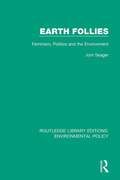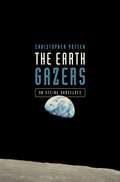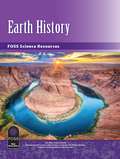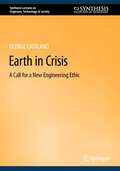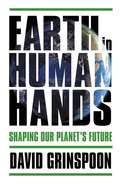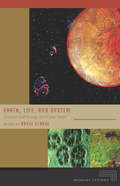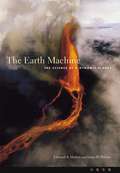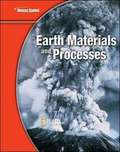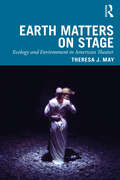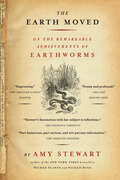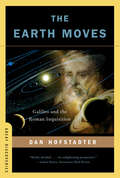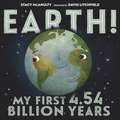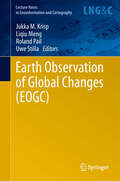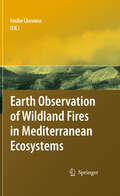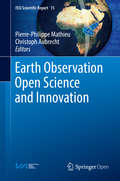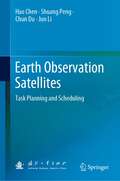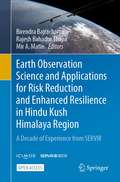- Table View
- List View
Earth Follies: Feminism, Politics and the Environment (Routledge Library Editions: Environmental Policy #11)
by Joni SeagerFirst published in 1993. The question of ‘agency’ is essential to our understanding of environmental problems - who is responsible, and why? Threats such as ozone depletion, global warming and overconsumption are all precipitated by the powerful institutions which shape modern life – institutions which are overwhelmingly controlled by men and dominated by masculine presumptions. Joni Seager argues that the gender bias inherent in western culture is inextricably linked to our environmental crisis. She analyses the traditional institutes of power – governments, the military and transnational corporations - and also takes a critical look at the equally patriarchal environmental establishment, comparing the work of the official environmental movement, grounded in masculine thought, with the smaller-scale, direct actions taken by women driven to protect their homes and communities. Earth Follies represents an incisive and utterly convincing feminist critique of our environmental crises, and offers radical and productive priorities for the environmental agenda.
The Earth Gazers: On Seeing Ourselves
by Christopher PotterIt will soon be the fiftieth anniversary of the first manned mission to the moon, when men first saw for themselves the Earth as a sphere falling through space—they saw a world without borders and these images continue to give hope and inspire. Only twenty-four people have seen the whole earth. The most beautiful and influential photographs ever made were taken, almost as an afterthought, by the astronauts of the Apollo space program from the moon. They inspired a generation of scientists and environmentalists to think more seriously about our responsibility for this tiny oasis in space, this “blue marble” falling through empty darkness. The Earth Gazers is a book about the long road to the capture of those unforgettable images. It is a history of the space program and of the ways in which it transformed our view of the earth and changed the lives of the astronauts who walked in space and on the moon. It is the story of the often blemished visionaries who inspired that journey into space: Charles Lindbergh, Robert Goddard and Wernher Von Braun, and of the courageous pilots who were the first humans to escape the Earth's orbit. These twenty-four people saw Earth in all its singular glory, and the legacy of the stories of these "Earth Gazers," resonate richly even today.
Earth History
by Lawrence Hall of Science University of California at BerkeleyNIMAC-sourced textbook
Earth History
by Lawrence Hall of Science University of California at BerkeleyNIMAC-sourced textbook
Earth History Resources: Images,Data and Readings
by FOSS Middle School Project Staff AssociatesScience Reader
Earth History Resources
by Lawrence Hall of Science University of California at BerkeleyNIMAC-sourced textbook
Earth in Crisis: A Call for a New Engineering Ethic (Synthesis Lectures on Engineers, Technology, & Society #26)
by George CatalanoThis book examines the ethical responsibilities of engineers and scientists in light of new advances in science with a distinct reflection on quantum mechanics. This thorough coverage of these new advances will assist the reader in rethinking our place in the universe and broadening a sense of ethical responsibility for the planet. This book addresses an approach to integrating these changes and deal with issues such as global climate change and the sixth extinction. This book compares new ideas in engineering that extend ethical boundaries beyond our present understanding in which Engineering ethics is locked in the world view of the 18th and 19th centuries. This books coverage examines how our understanding of the world has changed due to developments in science and society to include green, humanitarian, social justice, and omnium approaches to the engineering profession. The coverage of societal and ethics in science and engineering practice are examined through four major areas. Green engineering is the design that promotes the use of processes and products that minimize pollution, promote sustainability, and protect human health without sacrificing economic viability and efficiency. Humanitarian engineering seeks to directly improve the well-being of poor, marginalized, or under-served communities, which often lack the means to address pressing problems. Engineering for social justice imagines a new kind of engineering firmly affixed to the common good. Finally, a new approach, omnium engineering, seeks to promote an engineering profession that considers the wants and needs of all life forms not only that of the human speciesThe scope of this treatise is to examine the premise that the earth is facing grave crises when confronting global climate change and the sixth extinction. Engineering may be the planet’s last best hope, but it requires a new ethic that takes a much broader view of the profession’s ethical responsibilities. Moreover, the engineering ethic is rooted in the science of the past (Newtonian mechanic). Science has changed (quantum mechanics) but the engineering world view has not. Embracing this new science will inevitably lead to a new story of our responsibilities towards the planet.
Earth in Human Hands: Shaping Our Planet's Future
by David GrinspoonFor the first time in Earth's history, our planet is experiencing a confluence of rapidly accelerating changes prompted by one species: humans. Climate change is only the most visible of the modifications we've made--up until this point, inadvertently--to the planet. And our current behavior threatens not only our own future but that of countless other creatures. By comparing Earth's story to those of other planets, astrobiologist David Grinspoon shows what a strange and novel development it is for a species to evolve to build machines, and ultimately, global societies with world-shaping influence. Without minimizing the challenges of the next century, Grinspoon suggests that our present moment is not only one of peril, but also great potential, especially when viewed from a 10,000-year perspective. Our species has surmounted the threat of extinction before, thanks to our innate ingenuity and ability to adapt, and there's every reason to believe we can do so again. Our challenge now is to awaken to our role as a force of planetary change, and to grow into this task. We must become graceful planetary engineers, conscious shapers of our environment and caretakers of Earth's biosphere. This is a perspective that begs us to ask not just what future do we want to avoid, but what do we seek to build? What kind of world do we want? Are humans the worst thing or the best thing to ever happen to our planet? Today we stand at a pivotal juncture, and the answer will depend on the choices we make.
Earth in Space (Student Guide and Source Book)
by Carol O'DonnellWith an appropriate curriculum and adequate instruction, middle school students can develop the skills of investigation and the understanding that scientific inquiry is guided by knowledge, observations, ideas, and questions.
Earth, Life, and System: Evolution and Ecology on a Gaian Planet (Meaning Systems)
by Bruce ClarkeExploring the broad implications of evolutionary theorist Lynn Margulis’s work, this collection brings together specialists across a range of disciplines, from paleontology, molecular biology, evolutionary theory, and geobiology to developmental systems theory, archaeology, history of science, cultural science studies, and literature and science. Addressing the multiple themes that animated Margulis’s science, the essays within take up, variously, astrobiology and the origin of life, ecology and symbiosis from the microbial to the planetary scale, the coupled interactions of earthly environments and evolving life in Gaia theory and earth system science, and the connections of these newer scientific ideas to cultural and creative productions. Dorion Sagan acquaints the reader with salient issues in Lynn Margulis’s scientific work, the controversies they raised, and the vocabulary necessary to follow the arguments. Sankar Chatterjee synthesizes several strands of current theory for the origin of life on earth. James Strick tells the intertwined origin stories of James Lovelock’s Gaia hypothesis and Margulis’s serial endosymbiosis theory. Jan Sapp explores the distinct phylogenetic visions of Margulis and Carl Woese. Susan Squier examines the epigenetics of embryologist and developmental biologist C. H. Waddington. Bruce Clarke studies the convergence of ecosystem ecology, systems theory, and science fiction between the 1960s and the 1980s. James Shapiro discusses the genome evolution that results not from random changes but rather from active cell processes. Susan Oyama shows how the concept of development balances an over-emphasis on genetic coding and other deterministic schemas. Christopher Witmore studies the ways in which a concentrated animal feeding operation, or CAFO, mixes up natural resources, animal lives, and human appetites. And Peter Westbroek brings the insights of earth system science toward a new worldview essential for a proper response to global change.
The Earth Machine: The Science of a Dynamic Planet
by James D. Webster Edmond A. MathezFrom the scorching center of Earth's core to the outer limits of its atmosphere, from the gradual process of erosion that carved the Grand Canyon to the earth-shaking fury of volcanoes and earthquakes, this fascinating book -- inspired by the award-winning Hall of Planet Earth at New York City's American Museum of Natural History -- tells the story of the evolution of our planet and of the science that makes it work. With the same exuberance and expertise they brought to the creation of the Hall of Planet Earth, co-curators Edmond A. Mathez and James D. Webster offer a guided tour of Earth's dynamic, 4.6-billion-year history. Including numerous full-color photographs of the innovative exhibit and helpful, easy-to-understand illustrations, the authors explore the major factors in our planet's evolution: how Earth emerged from the swirling dusts of a nascent solar system; how an oxygen-rich, life-sustaining atmosphere developed; how continents, mountain ranges, and oceans formed; and how earthquakes and volcanic eruptions alter Earth's surface. Traversing geologic time and delving into the depths of the planet- -- beginning with meteorites containing minuscule particles that are the solar system's oldest known objects, and concluding with the unusual microbial life that lives on the chemical and thermal energy produced by sulfide vents in the ocean floor -- The Earth Machine provides an up-to-date overview of the central theories and discoveries in earth science today. By incorporating stories of real-life fieldwork, Mathez and Webster explain how Earth is capable of supporting life, how even the smallest rocks can hold the key to explaining the formation of mountains, and how scientists have learned to read nature's subtle clues and interpret Earth's ever-evolving narrative.
Earth Materials and Processes
by Glencoe Mcgraw-HillDiscover the Flexibility to Teach Science Your Way!. "Glencoe Science: Earth Materials and Processes," a module in the Glencoe Science 15 book series, provides students with accurate and comprehensive coverage of middle school National Science Education Standards. Concepts are explained in a clear, concise manner, and are integrated with a wide range of hands-on experiences, critical thinking opportunities, real-world applications, and connections to other sciences and to non-science areas of the curriculum. Co-authored by National Geographic, unparalleled graphics reinforce key concepts. A broad array of print and technology resources help differentiate and accommodate all learners. The modular approach allows you to mix and match books to meet your specific curriculum needs.
Earth Matters on Stage: Ecology and Environment in American Theater (Routledge Studies in Theatre, Ecology, and Performance)
by Theresa J. MayEarth Matters on Stage: Ecology and Environment in American Theater tells the story of how American theater has shaped popular understandings of the environment throughout the twentieth century as it argues for theater’s potential power in the age of climate change. Using cultural and environmental history, seven chapters interrogate key moments in American theater and American environmentalism over the course of the twentieth century in the United States. It focuses, in particular, on how drama has represented environmental injustice and how inequality has become part of the American environmental landscape. As the first book-length ecocritical study of American theater, Earth Matters examines both familiar dramas and lesser-known grassroots plays in an effort to show that theater can be a powerful force for social change from frontier drama of the late nineteenth century to the eco-theater movement. This book argues that theater has always and already been part of the history of environmental ideas and action in the United States. Earth Matters also maps the rise of an ecocritical thought and eco-theater practice – what the author calls ecodramaturgy – showing how theater has informed environmental perceptions and policies. Through key plays and productions, it identifies strategies for artists who want their work to contribute to cultural transformation in the face of climate change.
The Earth Moved: On the Remarkable Achievements of Earthworms
by Amy StewartIn The Earth Moved, Amy Stewart takes us on a journey through the underground world and introduces us to one of its most amazing denizens. The earthworm may be small, spineless, and blind, but its impact on the ecosystem is profound. It ploughs the soil, fights plant diseases, cleans up pollution, and turns ordinary dirt into fertile land. Who knew? <P><P>In her witty, offbeat style, Stewart shows that much depends on the actions of the lowly worm. Charles Darwin devoted his last years to the meticulous study of these creatures, praising their remarkable abilities. With the august scientist as her inspiration, Stewart investigates the worm's subterranean realm, talks to oligochaetologists—the unsung heroes of earthworm science—who have devoted their lives to unearthing the complex life beneath our feet, and observes the thousands of worms in her own garden. <P> From the legendary giant Australian worm that stretches to ten feet in length to the modest nightcrawler that wormed its way into the heart of Darwin's last book to the energetic red wigglers in Stewart's compost bin, The Earth Moved gives worms their due and exposes their hidden and extraordinary universe. This book is for all of us who appreciate Mother Nature's creatures, no matter how humble.
The Earth Moves: Galileo and the Roman Inquisition (Great Discoveries)
by Dan HofstadterA cogent portrayal of a turning point in the evolution of the freedom of thought and the beginnings of modern science. Celebrated, controversial, condemned, Galileo Galilei is a seminal figure in the history of science. Both Stephen Hawking and Albert Einstein credit him as the first modern scientist. His 1633 trial before the Holy Office of the Inquisition is the prime drama in the history of the conflict between science and religion. Galileo was then sixty-nine years old and the most venerated scientist in Italy. Although subscribing to an anti-literalist view of the Bible, as per Saint Augustine, Galileo considered himself a believing Catholic. Playing to his own strengths--a deep knowledge of Italy, a longstanding interest in Renaissance and Baroque lore--Dan Hofstadter explains this apparent paradox and limns this historic moment in the widest cultural context, portraying Galileo as both humanist and scientist, deeply versed in philosophy and poetry, on easy terms with musicians, writers, and painters.
Earth! My First 4.54 Billion Years (Our Universe #1)
by Stacy McAnultyA lighthearted nonfiction picture book about the formation and history of the Earth--told from the perspective of the Earth itself!"Hi, I’m Earth! But you can call me Planet Awesome." Prepare to learn all about Earth from the point-of-view of Earth herself! In this funny yet informative book, filled to the brim with kid-friendly facts, readers will discover key moments in Earth’s life, from her childhood more than four billion years ago all the way up to present day. Beloved children's book author Stacy McAnulty helps Earth tell her story, and award-winning illustrator David Litchfield brings the words to life. The book includes back matter with even more interesting tidbits.This title has Common Core connections.
Earth Observation of Global Changes (EOGC)
by Jukka M. Krisp Liqiu Meng Roland Pail Uwe StillaThis book provides a collection of selected articles that have been submitted to the Earth Observation and Global Changes (EOGC2011) Conference. All articles have been carefully reviewed by an international board of top-level experts. The book covers a wide variety of topics including Physical Geodesy, Photogrammetry & Remote Sensing, High-Resolution and Fast-Revisiting Remote Sensing Satellite Systems, Global Change & Change Detection, Spatial Modelling, GIS & Geovisualization. The articles document concrete results of current studies related to Earth Sciences. The book is intended for researchers and experts working in the area of Spatial Data Analysis, Environmental Monitoring/Analysis, Global Change Monitoring and related fields.
Earth Observation of Wildland Fires in Mediterranean Ecosystems
by Emilio ChuviecoWildland fires are becoming one of the most critical environmental factors affecting a wide range of ecosystems worldwide. In Mediterranean ecosystems (including also South-Africa, California, parts of Chile and Australia), wildland fires are recurrent phenomena every summer, following the seasonal drought. As a result of changes in traditional land use practices, and the impact of recent climate warming, fires have more negative impacts in the last years, threatening lives, socio-economic and ecological values. The book describes the ecological context of fires in the Mediterranean ecosystems, and provides methods to observe fire danger conditions and fire impacts using Earth Observation and Geographic Information System technologies.
Earth Observation Open Science and Innovation (ISSI Scientific Report Series #15)
by Pierre-Philippe Mathieu Christoph AubrechtThis book is published open access under a CC BY 4. 0 license. Over the past decades, rapid developments in digital and sensing technologies, such as the Cloud, Web and Internet of Things, have dramatically changed the way we live and work. The digital transformation is revolutionizing our ability to monitor our planet and transforming the way we access, process and exploit Earth Observation data from satellites. This book reviews these megatrends and their implications for the Earth Observation community as well as the wider data economy. It provides insight into new paradigms of Open Science and Innovation applied to space data, which are characterized by openness, access to large volume of complex data, wide availability of new community tools, new techniques for big data analytics such as Artificial Intelligence, unprecedented level of computing power, and new types of collaboration among researchers, innovators, entrepreneurs and citizen scientists. In addition, this book aims to provide readers with some reflections on the future of Earth Observation, highlighting through a series of use cases not just the new opportunities created by the New Space revolution, but also the new challenges that must be addressed in order to make the most of the large volume of complex and diverse data delivered by the new generation of satellites.
Earth Observation Satellites: Task Planning and Scheduling
by Hao Chen Shuang Peng Chun Du Jun LiThis book highlights the practical models and algorithms of earth observation satellite (EOS) task scheduling. EOS task scheduling is a typical complex combinatorial optimization problem with NP-Hard computational complexity. It is a key technology in aerospace scheduling and has attracted global attention. Based on the actual needs of the EOS operation control center, the book summarizes and reviews the state of the art in this research and engineering field. In both deterministic scenarios and dynamic scenarios, the book elaborates on the typical models, algorithms, and systems in centralized, distributed, and onboard autonomous task scheduling. The book also makes an outlook on the promising technologies for EOS task planning and scheduling in the future. It is a valuable reference for professionals, researchers, and students in satellite-related technology. This book is a translation of an original Chinese edition. The translation was done with the help of artificial intelligence. A subsequent human revision was done primarily in terms of content, so that the book will read stylistically differently from a conventional translation.
Earth Observation Science and Applications for Risk Reduction and Enhanced Resilience in Hindu Kush Himalaya Region: A Decade of Experience from SERVIR
by Birendra Bajracharya Rajesh Bahadur Thapa Mir A. MatinThis open access book is a consolidation of lessons learnt and experiences gathered from our efforts to utilise Earth observation (EO) science and applications to address environmental challenges in the Hindu Kush Himalayan region. It includes a complete package of knowledge on service life cycles including multi-disciplinary topics and practically tested applications for the HKH. It comprises 19 chapters drawing from a decade’s worth of experience gleaned over the course of our implementation of SERVIR-HKH – a joint initiative of NASA, USAID, and ICIMOD – to build capacity on using EO and geospatial technology for effective decision making in the region. The book highlights SERVIR’s approaches to the design and delivery of information services – in agriculture and food security; land cover and land use change, and ecosystems; water resources and hydro-climatic disasters; and weather and climate services. It also touches upon multidisciplinary topics such as service planning; gender integration; user engagement; capacity building; communication; and monitoring, evaluation, and learning. We hope that this book will be a good reference document for professionals and practitioners working in remote sensing, geographic information systems, regional and spatial sciences, climate change, ecosystems, and environmental analysis. Furthermore, we are hopeful that policymakers, academics, and other informed audiences working in sustainable development and evaluation – beyond the wider SERVIR network and well as within it – will greatly benefit from what we share here on our applications, case studies, and documentation across cross-cutting topics.
